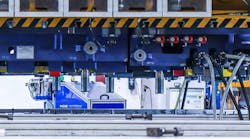Presses in stamping and forming tools generally operate in a path-controlled manner. The length of the path in the clinching process is predefined. There are certain influencing factors in the system that can lead to different results in the clinching process due to the predefined path. These influencing factors are the height tolerances of the fasteners, the tolerances in the sheet thickness and the setup of the press.
Due to these influences, the actual press-in distance is lengthened or shortened. A path-controlled setting process is not optimal because the lengthening of the path is accompanied with an increase in the press-in force, and vice-versa. The variations in press-in force lead to different results: Either the fasteners are pressed in not deep enough or they are pressed in too deep. This leads to a decrease in the quality of the emerging sheet metal connection.
Such influencing factors can be compensated in a force-controlled setting process. The use of a gas compression spring ensures consistent results because the press-in distance can be shortened or lengthened. Each fastener is applied with the optimal press-in force and therefore ideally installed.
For optimal results, attention should be paid to the proper adjustment and monitoring of the press-in force when using a gas compression spring. The force-controlled setting process is highly recommended, especially for fasteners with internal threads (clinch nuts)—assuming that the spatial conditions in the tool enable the installation of a gas compression spring.
The work of the press operator can be simplified and sped up considerably with the use of a force-controlled system. During press setup, the operator only has to focus on the sheet metal. Subsequent fine-tuning with a view on the produced sheet metal joints is not required. That means shorter downtimes of the press and much faster startup.
A force-controlled system provides constant clinching results and consistent quality of the sheet metal connection. Uniform performance of the fasteners is ensured. The run-in speed of a tool is increased and a higher output, with higher quality and lower unit costs, can be achieved.
Elias Herb is online marketing manager for MDS Autoriv.

